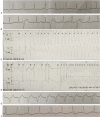QTc prolongation and torsades de pointes due to a coadministration of fluoxetine and amiodarone in a patient with implantable cardioverter-defibrillator: Case report and review of the literature
- PMID: 29245320
- PMCID: PMC5728935
- DOI: 10.1097/MD.0000000000009071
QTc prolongation and torsades de pointes due to a coadministration of fluoxetine and amiodarone in a patient with implantable cardioverter-defibrillator: Case report and review of the literature
Abstract
Rationale: Drug-induced prolongation of the corrected QT interval (QTc) may lead to serious and potentially life-threatening ventricular tachyarrhythmia, such as torsades de pointes (Tdp), which is worthy of clinical attention. Here, we report 1 case of Tdp after a coadministration of fluoxetine and amiodarone.
Patient concerns: A 62-year-old Chinese male who placed with the implanted cardioverter-defibrillator (ICD) appeared the QTc prolongation and Tdp after the concurrent administration of fluoxetine and amiodarone.
Diagnoses: Torsades de pointes (Tdp).
Interventions: The patient was treated with magnesium and potassium immediately. Her ICD-brady pacing mode was reprogrammed to 90 bpm. Meanwhile, both of fluoxetine and amiodarone were discontinued.
Outcomes: The further episodes of Tdp were prevented. After a few days, the QTc gradually decreased without clinically significant arrhythmias.
Lessons: The present case demonstrates that a potential drug-drug interaction (DDI) may lead to a life-threatening drug adverse reaction (ADR) especially in special subjects. Therefore, clinicians should closely monitor the electrocardiogram (ECG) when QTc-prolonging agents are given to patients with cardiac abnormalities, and avoid combining 2 QTc-prolonging drugs.
Conflict of interest statement
The authors report no conflicts of interest in this work.
Figures

Similar articles
-
QT Interval prolongation and torsades de pointes due to a coadministration of ciprofloxacin and azimilide in a patient with implantable cardioverter-defibrillator.Pacing Clin Electrophysiol. 2007 Aug;30(8):1043-6. doi: 10.1111/j.1540-8159.2007.00809.x. Pacing Clin Electrophysiol. 2007. PMID: 17669094
-
Torsade de pointes induced by intravenous and long-term oral amiodarone therapy in a patient with dilated cardiomyopathy.Jpn Circ J. 2001 Mar;65(3):236-8. doi: 10.1253/jcj.65.236. Jpn Circ J. 2001. PMID: 11266201
-
QT interval prolongation and torsades de pointes due to a coadministration of metronidazole and amiodarone.Pacing Clin Electrophysiol. 2005 May;28(5):472-3. doi: 10.1111/j.1540-8159.2005.09348.x. Pacing Clin Electrophysiol. 2005. PMID: 15869686
-
QT interval prolongation and torsades de pointes in a patient undergoing treatment with vorinostat: a case report and review of the literature.Cardiol J. 2012;19(4):434-8. Cardiol J. 2012. PMID: 22825908 Review.
-
[Torsades de pointes ventricular tachycardia induced by intravenous amiodarone].Orv Hetil. 2003 Feb 2;144(5):241-7. Orv Hetil. 2003. PMID: 12647553 Review. Hungarian.
Cited by
-
Detection of Clinically Significant Drug-Drug Interactions in Fatal Torsades de Pointes: Disproportionality Analysis of the Food and Drug Administration Adverse Event Reporting System.J Med Internet Res. 2025 Mar 25;27:e65872. doi: 10.2196/65872. J Med Internet Res. 2025. PMID: 40132181 Free PMC article.
-
Oxytocin exerts harmful cardiac repolarization prolonging effects in drug-induced LQTS.Int J Cardiol Heart Vasc. 2022 Apr 3;40:101001. doi: 10.1016/j.ijcha.2022.101001. eCollection 2022 Jun. Int J Cardiol Heart Vasc. 2022. PMID: 35391783 Free PMC article.
References
-
- Roden DM. Drug-induced prolongation of the QT interval. N Engl J Med 2004;350:1013–22. - PubMed
-
- Tully PJ, Harrison NJ, Cheung P, et al. Anxiety and cardiovascular disease risk: a review. Curr Cardiol Rep 2016;18:120. - PubMed
-
- Beach SR, Kostis WJ, Celano CM, et al. Meta-analysis of selective serotonin reuptake inhibitor-associated QTc prolongation. J Clin Psychiatry 2014;75:e441–9. - PubMed
-
- Strik JJ, Honig A, Lousberg R, et al. Efficacy and safety of fluoxetine in the treatment of patients with major depression after first myocardial infarction: findings from a double-blind, placebo-controlled trial. Psychosom Med 2000;62:783–9. - PubMed
Publication types
MeSH terms
Substances
LinkOut - more resources
Full Text Sources
Other Literature Sources
Medical
Research Materials

